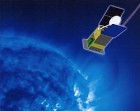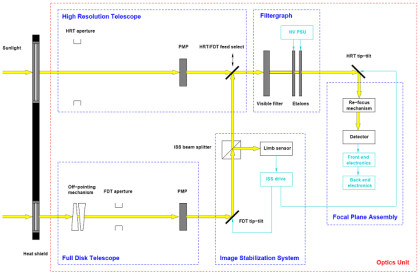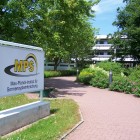Polarimetric and Helioseismic Imager (PHI)
A proposed instrument for the Solar Orbiter mission
referencing the Visible-light Imager and Magnetograph
 PHI is a diffraction limited, wavelength tunable, quasi-monochromatic, polarisation sensitive imager to be build by a consortium that has a long-standing expertise in designing and building scientific instruments for space missions. The instrument will be developed with major contributions from institutes in Germany, Spain and France, and smaller contributions from Sweden, Norway and Switzerland.
PHI is a diffraction limited, wavelength tunable, quasi-monochromatic, polarisation sensitive imager to be build by a consortium that has a long-standing expertise in designing and building scientific instruments for space missions. The instrument will be developed with major contributions from institutes in Germany, Spain and France, and smaller contributions from Sweden, Norway and Switzerland.
Science Objectives
PHI will provide maps of the magnetic vector and of the line-of-sight (LOS) velocity in the solar photosphere. It will thus probe the deepest layers of the Sun (including the solar interior using helioseismology) of all the instruments on Solar Orbiter or the Inner Heliospheric Sentinels. Since the magnetic field anchored at the solar surface produces most of the structures and energetic events in the upper solar atmosphere and significantly influences the heliosphere, PHI plays a key role in reaching the science goals of Solar Orbiter. Extrapolations of the magnetic field observed by PHI into the Sun’s upper atmosphere and heliosphere will provide the information needed for other optical and in-situ instruments to analyse and understand the data recorded by them in a proper physical context.
![[Top]](/images/icons/top.gif)
The Instrument
 PHI will be composed of two telescopes. The off-axis Ritchey-Chrétien High Resolution Telescope (HRT) will image a fraction of the solar disk at a resolution reaching 150 km at perihelion (the same resolution as the Extreme Ultraviolet Imager’s high resolution channels will have). The refractor Full Disk Telescope (FDT) will be able to image the full solar disk at all phases of the orbit. It incorporates an off-pointing capability. Each telescope will have its own Polarization Modulation Package (PMP) located early in the optical path in order to minimize polarisation cross-talk effects. Polarimetry at a signal to noise level of 10^3 is baselined for PHI. The HRT and the FDT will sequentially send light to a Fabry-Perot filtergraph system (~ 100 mÅ spectral resolution) and on to a 2048 × 2048 pixel CMOS sensor. PHI will have its own Image Stabilization System (ISS) that will compensate spacecraft jitter or other disturbances. This system will be composed of a limb sensor and separate rapid tip-tilt mirrors for the FDT and the HRT.
PHI will be composed of two telescopes. The off-axis Ritchey-Chrétien High Resolution Telescope (HRT) will image a fraction of the solar disk at a resolution reaching 150 km at perihelion (the same resolution as the Extreme Ultraviolet Imager’s high resolution channels will have). The refractor Full Disk Telescope (FDT) will be able to image the full solar disk at all phases of the orbit. It incorporates an off-pointing capability. Each telescope will have its own Polarization Modulation Package (PMP) located early in the optical path in order to minimize polarisation cross-talk effects. Polarimetry at a signal to noise level of 10^3 is baselined for PHI. The HRT and the FDT will sequentially send light to a Fabry-Perot filtergraph system (~ 100 mÅ spectral resolution) and on to a 2048 × 2048 pixel CMOS sensor. PHI will have its own Image Stabilization System (ISS) that will compensate spacecraft jitter or other disturbances. This system will be composed of a limb sensor and separate rapid tip-tilt mirrors for the FDT and the HRT.
![[Top]](/images/icons/top.gif)
MPS Contribution
The MPS will be assigned with the system responsibility for the implementation of the PHI instrument. This comprises the development of a stable housing and its connections to the spacecraft's main body. Due to the close solar proximity during Solar Orbiter's perihelion passages all instrument components are subject to stringent conditions regarding radiation hardness and thermal stability.
The MPS will be responsible for the full opto-mechanical development of the High Resolution Telescope. The prospective optical concept will be based on an off-axis Ritchey-Crètien telescope with an aperture diameter of 160 mm and an effective focal length of approximately 2500 mm. An off-axis design is preferred since it causes reduced thermal stabilisation complexities which pose the main challenges of the instrumental design. In addition, a feed select mechanism for choosing between the two telescopes will be developed under authority of the MPS.
The MPS will provide the focal plane assembly of the PHI instrument. This comprises the development of a fast 2k x 2k APS-detector system and the associated front-end electronics which can be qualified for the space mission.
![[Top]](/images/icons/top.gif)
The Team
| Principal Investigator |
Prof. Dr. Sami Solanki |
| Project Manager |
Dr. Joachim Woch |
| Project Scientist |
Dr. Achim Gandorfer |
| Co-Investigator |
Dr. Laurent Gizon
Dr. Johann Hirzberger
Dr. Andreas Lagg
Dr. Udo Schühle
Dr. Lotfi Yelles Chaouche
|
| System Engineering |
Reinhard Meller |
| System Integration Lead |
Werner Deutsch |
| Product Assurance |
Henry Perplies |
| Configuration Control |
Hendrik Raasch |
![[Top]](/images/icons/top.gif)
Related links




